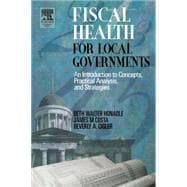
| Preface and Acknowledgments | vii | ||||
| Foreword | xi | ||||
| 1. Introduction and Overview | 1 | (16) | |||
|
2 | (2) | |||
|
4 | (1) | |||
|
5 | (5) | |||
|
10 | (2) | |||
|
12 | (1) | |||
|
12 | (2) | |||
|
14 | (1) | |||
|
15 | (2) | |||
| 2. Fiscal Health Literature: Drifts and Reflections | 17 | (22) | |||
|
17 | (5) | |||
|
22 | (2) | |||
|
24 | (7) | |||
|
31 | (2) | |||
|
33 | (1) | |||
|
33 | (6) | |||
| 3. Macro Trends Affecting Local Governments | 39 | (26) | |||
|
40 | (6) | |||
|
46 | (1) | |||
|
47 | (3) | |||
|
50 | (2) | |||
|
52 | (1) | |||
|
53 | (1) | |||
|
54 | (1) | |||
|
55 | (5) | |||
|
60 | (1) | |||
|
60 | (1) | |||
|
61 | (4) | |||
| 4. Financing Trends and Options | 65 | (42) | |||
|
66 | (2) | |||
|
68 | (5) | |||
|
73 | (5) | |||
|
78 | (3) | |||
|
81 | (2) | |||
|
83 | (2) | |||
|
85 | (1) | |||
|
86 | (3) | |||
|
89 | (3) | |||
|
92 | (2) | |||
|
94 | (1) | |||
|
95 | (1) | |||
|
96 | (2) | |||
|
98 | (1) | |||
|
99 | (1) | |||
|
100 | (1) | |||
|
101 | (6) | |||
| 5. Alternative Service Delivery (ASD) Options | 107 | (32) | |||
|
109 | (1) | |||
|
110 | (3) | |||
|
113 | (8) | |||
|
121 | (4) | |||
|
125 | (1) | |||
|
125 | (2) | |||
|
127 | (1) | |||
|
128 | (1) | |||
|
129 | (1) | |||
|
130 | (3) | |||
|
133 | (2) | |||
|
135 | (1) | |||
|
136 | (1) | |||
|
136 | (3) | |||
| 6. Tools for Analyzing Local Fiscal Health | 139 | (38) | |||
|
140 | (4) | |||
|
144 | (7) | |||
|
151 | (1) | |||
|
152 | (17) | |||
|
169 | (1) | |||
|
170 | (1) | |||
|
171 | (6) | |||
| 7. Analysis and Interpretation | 177 | (18) | |||
|
178 | (5) | |||
|
183 | (4) | |||
|
187 | (5) | |||
|
192 | (3) | |||
| 8. Fiscal Effects of Local Government Boundary Adjustments | 195 | (24) | |||
|
195 | (2) | |||
|
197 | (2) | |||
|
199 | (17) | |||
|
201 | (9) | |||
|
201 | (2) | |||
|
203 | (1) | |||
|
204 | (2) | |||
|
o5 | ||||
|
206 | (1) | |||
|
206 | (3) | |||
|
209 | (1) | |||
|
210 | (6) | |||
|
210 | (2) | |||
|
212 | (1) | |||
|
212 | (1) | |||
|
213 | (1) | |||
|
214 | (1) | |||
|
214 | (2) | |||
|
216 | (1) | |||
|
217 | (1) | |||
|
217 | (2) | |||
| 9. Practical Strategies for Local Fiscal Health | 219 | (22) | |||
|
228 | (1) | |||
|
229 | (2) | |||
|
231 | (1) | |||
|
232 | (1) | |||
|
233 | (1) | |||
|
234 | (1) | |||
|
235 | (1) | |||
|
236 | (1) | |||
|
237 | (1) | |||
|
238 | (1) | |||
|
239 | (2) | |||
| 10. Conclusion | 241 | (10) | |||
| References | 251 | (2) | |||
| About the Authors | 253 | (4) | |||
| Index | 257 |
The New copy of this book will include any supplemental materials advertised. Please check the title of the book to determine if it should include any access cards, study guides, lab manuals, CDs, etc.
The Used, Rental and eBook copies of this book are not guaranteed to include any supplemental materials. Typically, only the book itself is included. This is true even if the title states it includes any access cards, study guides, lab manuals, CDs, etc.